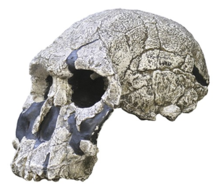Kenyanthropus
Kenyanthropus is a hominin genus identified from the Lomekwi site by Lake Turkana, Kenya, dated to 3.3 to 3.2 million years ago during the Middle Pliocene. It contains one species, K. platyops, but may also include the 2 million year old Homo rudolfensis, or K. rudolfensis. Before its naming in 2001, Australopithecus afarensis was widely regarded as the only australopithecine to exist during the Middle Pliocene, but Kenyanthropus evinces a greater diversity than once acknowledged. Kenyanthropus is most recognisable by an unusually flat face and small teeth for such an early hominin, with values on the extremes or beyond the range of variation for australopithecines in regard to these features. Multiple australopithecine species may have coexisted by foraging for different food items (niche partitioning), which may be reason why these apes anatomically differ in features related to chewing.
The Lomekwi site also yielded the earliest stone tool industry, the Lomekwian, characterised by the rudimentary production of simple flakes by pounding a core against an anvil or with a hammerstone. It may have been manufactured by Kenyanthropus, but it is unclear if multiple species were present at the site or not. The knappers were using volcanic rocks collected no more than 100 m (330 ft) from the site. Kenyanthropus seems to have lived on a lakeside or floodplain environment featuring forests and grasslands.
In August 1998, field technician Blasto Onyango discovered a hominin partial left maxilla (upper jaw), specimen KNM-WT 38350, on the Kenyan Lomekwi dig site by Lake Turkana, overseen by prominent paleoanthropologists Louise and Meave Leakey. In August 1999 at the Lomewki site, research assistant Justus Erus discovered an uncharacteristically flat-faced australopithecine skull, specimen KNM-WT 40000. The 1998–1999 field season subsequently uncovered 34 more craniodental hominin specimens, but the research team was unable to determine if these can be placed into the same species as the former two specimens (that is, if multiple species were present at the site).[1]
The specimens were recovered near the Nabetili tributary of the Lomekwi river in a mudstone layer of the Nachukui Formation. KNM-WT 40000 was recovered from the Kataboi Member, 8 m (26 ft) below the 3.4 million year old Tulu Bor Tuff, and 12 m (39 ft) above the 3.57 million year old Lokochot Tuff. By linear interpolation, KNM-WT 40000 is approximately 3.5 million years old, dating back to the Middle Pliocene. Only three more specimens were recovered from the Kataboi Member at around the same level, the deepest KNM-WT 38341 probably sitting on 3.53 million year old sediments. KNM-WT 38350 was recovered from the Lomekwi Member 17 m (56 ft) above Tulu Bor, and is approximately 3.3 million years old. The other specimens from this member sit 16 to 24 m (52 to 79 ft) above Tulu Bor, roughly 3.3 million years old as well. The highest specimens—KNM-WT 38344, -55, and -56—may be around 3.2 million years old.[1]
In 2001, Meave Leakey and colleagues assigned the Lomekwi remains to a new genus and species, Kenyanthropus platyops, with KNM-WT 40000 the holotype, and KNM-WT 38350 a paratype. The genus name honours Kenya where Lomekwi and a slew of other major human-ancestor sites have been identified. The species name derives from Ancient Greek platus "flat" and opsis "face" in reference to the unusually flat face for such an early hominin.[1]



